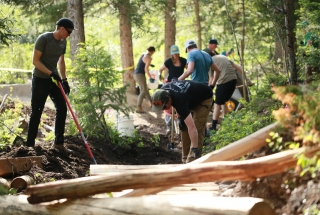One Trail at a Time
- Uncategorized
- January 13, 2023
- Share
While the trails may seem to fit into the natural landscape, it’s no accident that they exist where they are. Canmore and Area Mountain Bike Association (CAMBA) president, Justin Deoliveira, shares insights into the thought and planning that goes into the trails that you enjoy—and how best to care for them.
Formed in 2016, CAMBA is a result of the idea that mountain bikers and the greater trail community like hikers, runners, and equestrians needed a voice to advocate for new trails and improvements.
Through relationships with key land managers such as the Town of Canmore, the Government of Alberta, and private landowners, as well as local bike shops, CAMBA has been able to accomplish a lot in a small amount of time.
“Forming those relationships allows us to become stewards of those trails, work on those trails, and advocate for new trails,” says Deoliveira.
What goes into building those trails you love? “The first piece is the concept,” says Deoliveira. “You need a picture of what you want to build.” Whether the trail will be green or double black, “you need a vision for it…then you need to find the terrain,” he explains.
The next step is getting the buy-in from the land manager, which can be challenging, says Deoliveira. “You need to leave space for the wildlife as much as you can.” You also need to cater to all user types, he says. In Canmore, there’s no such thing as just a bike trail because you’re sharing the space with hikers, runners, and people on horseback.
Sustainability of the trail is another key consideration, which comes down to how the trail is built, Deoliveira explains. Depending on the dirt quality, a trail mix needs to be used to ensure a hardened surface that will last decades.
The finishing touches include signage with things like the difficulty level. “Good trail signage is a key component to creating a good experience for trail users,” says Deoliveira.
“One of the concepts that have emerged in modern-day trail signage is the idea of pre-ride, re-ride, and freeride,” he notes.
Etiquette on the trail is all about RESPECT:
Ride within your ability: Know you can stop, know the terrain and difficulty of the trail you’re riding.
Earn your turns: Donate to your trail association, volunteer on trail days.
Share the trails: Watch for other users, make way for climbing traffic, dismount for equestrians.
Plan ahead: Be bear aware, carry bear spray, carry an emergency kit with food and tools.
Expect the unexpected: Expect technical features, keep in control, report fallen trees and concerns.
Closed means closed: Obey signage and closures, stay on designated trails, avoid wet/thawing trails.
Take it home: Pack it in, pack it out, dispose of garbage at appropriate facilities, clean up after pets.
One more thing: Never wear earbuds, Deoliveira warns. Making noise and being able to hear one another are important for safety. Noise is a key component to ensure that users interact safely with each other, and with wildlife.
It’s also important to respect designated trails and be aware if you find yourself on an unofficial trail. “Wildlife is its own specific piece,” he adds. “We’re lucky to have this ecosystem and being on a non-designated trail, while seemingly harmless, can have a negative impact on wildlife as you encroach on their space.”
Learn more about the unique ecosystem from the Biosphere Institute of the Bow Valley.
Advocacy, trail building, and community are at the core of what CAMBA does, from social events to education and partnerships, Deoliveira explains.
“As a trail association, we build and maintain trails, but we also face this challenge that trail usage is a non-diverse place,” he says. CAMBA partners with local associations whose missions address that, such as Rocky Mountain Adaptive, Spirit North, and Darken the Mountains.
Discover what makes Canmore and Kananaskis special, from the people who know it best. Think differently, travel more sustainably, and gain a deeper understanding of the mountains with Peaks Academy. Learn more.
